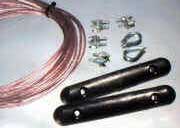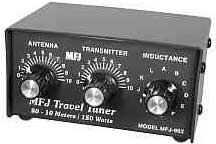Wednesday 14 June, 2006, 08:22 - Amateur Radio
For a while now, I've been considering how best to go about installing a decent multi-band HF antenna that would be unobtrusive but still work. I first tried a long inverted-L made of thin wire running down the garden using the house-hold central heating system as an earth (yes, yes, I know this is a no, no, but it's all I could get my hands on in the area available). It wasn't totally invisible but was largely unobtrusive. It resonated at about 2.5 MHz and with a simple ATU I could tune it to get a low SWR on all bands from 160m (the top end only) to 6m. Of course it's difficult to measure the effectiveness of such an antenna but I did manage one or two true 'DX' contacts with Hong Kong (5976 miles), Tokyo (5915 miles) and Sao Paulo (5984 miles) on bands ranging from 17 to 10 metres. The downside to the antenna was that it received rather a lot of background noise, probably because the vertical portion of the 'L' ran close to lots of IT equipment. I also discovered that next door's television was a major source of RF interference on 20 metres too! However, I couldn't help but feel that performance was probably not even as effective as a straightforward dipole. Having measured my loft, I realised that I only had about 9 metres of space to play with - enough for a 17 metre dipole, but not much more. After a bit of digging around I found an antenna made by WiMO of Germany, which used the fact that, below their resonant frequency, tuned 'L-C' traps become inductors and as such have the effect of electrically shortening an antenna. With clever positioning of two sets of traps, they have produced a trapped-dipole that covers 20, 15 and 10 metres in an overall, occupied space of only 8 metres. This sounded like just the thing for my loft so I ordered one. A week later it arrived.
However, I couldn't help but feel that performance was probably not even as effective as a straightforward dipole. Having measured my loft, I realised that I only had about 9 metres of space to play with - enough for a 17 metre dipole, but not much more. After a bit of digging around I found an antenna made by WiMO of Germany, which used the fact that, below their resonant frequency, tuned 'L-C' traps become inductors and as such have the effect of electrically shortening an antenna. With clever positioning of two sets of traps, they have produced a trapped-dipole that covers 20, 15 and 10 metres in an overall, occupied space of only 8 metres. This sounded like just the thing for my loft so I ordered one. A week later it arrived. Installation was a cinch, mounting the centre balun transformer from a hook at the apex of the loft, and dangling the two antenna wires over the rafters to sit as close to the roof (and thus as high) as possible. I quickly ran to the shack to see whether or not such an antenna could cope with being in such a confined space (where, I should add, there are electrical cables feeding loft lights as well as a television antenna, splitter and various down-leads and a loft ladder, all of which could de-tune the antenna). A quick tune around and I have to say I was impressed: with no tweaking at all, the antenna provided a perfect 1:1 match at 28.0, 21.05 and 14.15 MHz - a little low in frequency for SSB working - but the match is relatively wide and a little intervention from my MFL-902 'Travel Tuner' ATU quickly solved that problem (oddly, the setting to raise the resonant frequency was the same on all 3 bands...)
Installation was a cinch, mounting the centre balun transformer from a hook at the apex of the loft, and dangling the two antenna wires over the rafters to sit as close to the roof (and thus as high) as possible. I quickly ran to the shack to see whether or not such an antenna could cope with being in such a confined space (where, I should add, there are electrical cables feeding loft lights as well as a television antenna, splitter and various down-leads and a loft ladder, all of which could de-tune the antenna). A quick tune around and I have to say I was impressed: with no tweaking at all, the antenna provided a perfect 1:1 match at 28.0, 21.05 and 14.15 MHz - a little low in frequency for SSB working - but the match is relatively wide and a little intervention from my MFL-902 'Travel Tuner' ATU quickly solved that problem (oddly, the setting to raise the resonant frequency was the same on all 3 bands...)How does the antenna perform? At the moment it's difficult to say. I haven't really had enough time to see whether its DX performance can equal my inverted-L, but what I can say is that (a) subjectively, signals on 10, 15 and 20 metres seem a good bit stronger all round than they did before and that (b) my neighbour's television now gives S9 of noise on 20m instead of S7!
 One final note - whilst my ATU will tune the antenna on the 12, 17, 30 and even 40 metre bands, unlike the inverted-L which comprised nothing other than a piece of wire, the WiMo antenna has a 1:1 balun at the centre. This ensures a much better match with the coax feed, and means that the coax down-lead does not radiate. However it does mean that, if the feed-point impedance of the antenna is not near 50 Ohms, there is a potential for much of the power travelling up the feeder to be absorbed by the balun, rather than making it to the antenna. Thus, whilst it might be possible to tune the antenna on these bands, there is a significant danger of burning out the balun - sodon't do it!
One final note - whilst my ATU will tune the antenna on the 12, 17, 30 and even 40 metre bands, unlike the inverted-L which comprised nothing other than a piece of wire, the WiMo antenna has a 1:1 balun at the centre. This ensures a much better match with the coax feed, and means that the coax down-lead does not radiate. However it does mean that, if the feed-point impedance of the antenna is not near 50 Ohms, there is a potential for much of the power travelling up the feeder to be absorbed by the balun, rather than making it to the antenna. Thus, whilst it might be possible to tune the antenna on these bands, there is a significant danger of burning out the balun - sodon't do it!